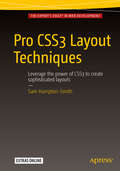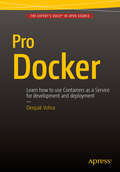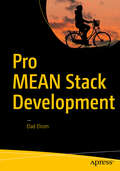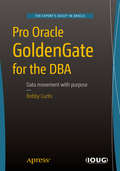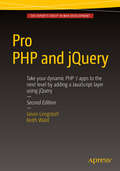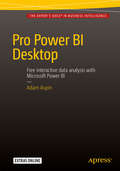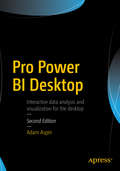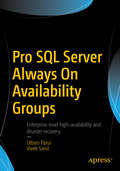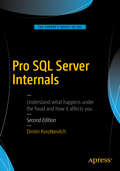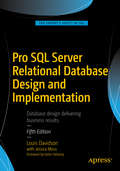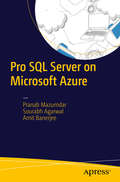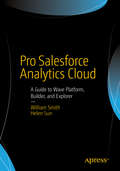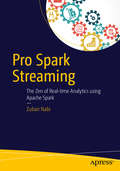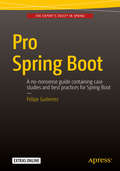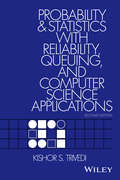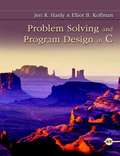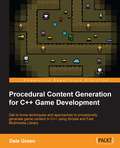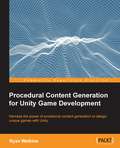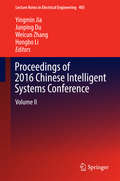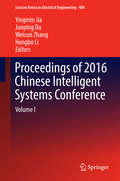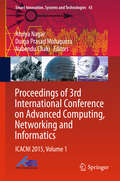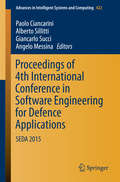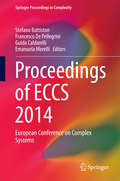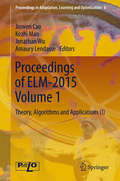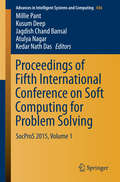- Table View
- List View
Pro CSS3 Layout Techniques
by Sam Hampton-SmithThis books demonstrates the freshest cutting-edge layout tools found within CSS3, teaching you the skills you'll need to create advanced design patterns for websites and apps. Pro CSS3 Layout Techniques teaches you how to make the most of CSS3's existing specification, including those parts of the specification already widely implemented, as well as the upcoming modules that are still being developed by the W3C. After reading this book you'll be able to confidently develop sophisticated, flexible layouts that aren't possible with CSS2. 1. CSS1 allowed designers to separate content from presentation for the first time and CSS2 cemented support for advanced typographical control, but neither specification provided more than rudimentary layout control. CSS3's latest additions allow designers to craft fully responsive, sophisticated layouts without the need for complex scripts or smoke-and-mirror workarounds. CSS3 is still in active development, with browser vendors racing against each other to implement the latest recommendations from the W3C. Pro CSS3 Layout Techniques will help you cut through the waffle and get straight to the heart of what works now, while showing you how to be ready for the future of CSS! What you'll learn * Teaches cutting-edge techniques for CSS3 layout * Covers all major CSS3 layout modules including multi-column, regions, and grid * Includes detailed coverage and examples of the new, powerful FlexBox * Features beta information on edge-modules in development * Covers use of libraries, frameworks and polyfills Who this book is for Pro CSS3 Layout Techniques is aimed at the web designer who yearns for the power and flexibility of print-layout tools, while keenly supporting the Responsive Web Design (RWD) approach to developing content that works across all devices. The book deals with a fundamental element of website design, but covers material many web professionals will be unaware of, making it an ideal purchase for all but the most technically sophisticated of web designers and developers. The book uses a tutorial-led approach to demonstrate real-world examples of new techniques, while providing an accessible reference guide for subsequent referral.
Pro Docker
by Deepak VohraIn this fast-paced book on the Docker open standards platform for developing, packaging and running portable distributed applications, author Deepak Vohra discusses how to build, ship and run applications on any platform such as a PC, the cloud, data center or a virtual machine. He describes how to install Docker images and create Docker containers, and the advantages of Docker containers. The remainder of the book is devoted to discussing using Docker with important software solutions. He begins by discussing using Docker with a traditional RDBMS using Oracle and MySQL. Next he moves on to NoSQL with chapter on MongoDB Cassandra, and Couchbase. Then he addresses the use of Docker in the Hadoop ecosystem with complete chapters on utilizing not only Hadoop, but Hive, HBase, Sqoop, Kafka, Solr and Spark. What you'll learn How to install a Docker image How to create a Docker container How to run an Application in a Docker Container Use Docker with Apache Hadoop Ecosystem Use Docker with NoSQL Databases Use Docker with RDBMS Who this book is for Apache Hadoop Developers. Database developers. NoSQL Developers. Table of Contents Section I Getting Started 1. Hello Docker 2. Installing Linux Section II Relational Databases 3. Oracle Database 4. MySQL Database Section III NoSQL Databases 5. MongoDB 6. Apache Cassandra 7. Couchbase Section IV Apache Hadoop Ecosystem 8. Apache Hadoop 9. Apache Hive 10. Apache HBase 11. Apache Sqoop 12. Apache Kafka 13. Apache Solr 14. Apache Spark
Pro MEAN Stack Development
by Elad ElromWrite free, open-source, cross-platform, dynamic JavaScript applications that can run anywhere using the MEAN stack - MongoDB, ExpressJS, AngularJS, and Node. js. With this book you will get the tools you need to set up, write your code once, and be able to deploy your code on any device. You will be able to cut development time by using one stack to serve all your development needs. Pro MEAN Stack Development enables you to quickly learn everything needed to work effectively with MEAN, from setting up your toolstack to rolling out your free servers, and deploying on any device. You will also learn to build scripts with Grunt and Gulp, Webpack, and Vagrant and how to deploy to the web and mobile using Phonegap. Harness JavaScript to create dynamic and easily-maintainable applications fast and 100% free. Master the MEAN stack with this book today. What You Will Learn Utilize JavaScript for the entire development cycle from front end to back end, database and deployment. Learn to write responsive code that can be deployed on any device. Become a well-rounded developer and be able to understand the entire development cycle. Learn to utilize free open source and cloud services to deploy production-grade code. Who This Book Is For Front or back end developers familiar with JavaScript and interested in utilizing the MEAN stack to deploy successful apps on all devices.
Pro Oracle GoldenGate for the DBA
by Bobby CurtisThis book provides a simple approach to learning the Oracle GoldenGate product. This approach provides the in-depth perspective of GoldenGate from an implementer's viewpoint; however, also addresses why the management viewpoint is important as well. Your journey through this book includes and architecture discussion of GoldenGate and the benefits of purchasing GoldenGate from a management perspective. Then the book quickly moves into advanced implementation components associated with GoldenGate. You'll find many use-cases and instructions throughout the book to help with everything from easy to complex GoldenGate implementations. An Oracle GoldenGate implementation generally consists of a group project, involving both business and technical resources. Pro Oracle GoldenGate for the DBA provides the viewpoint from the DBA's vantage point. This approach provides the components of who, what, why, when, and how in defining the implementation and support of a GoldenGate project. The success of most technical projects require the support of multiple resource groups, and Pro Oracle GoldenGate for the DBA supplies the insight for the DBA member to understand the implementation and support process. Takes you through justification, installation, and support. Provides the DBA perspective toward a successful a result. Covers from basic toward increasingly advanced implementations What you'll learn Understand the core architecture of data replication using Oracle GoldenGate Implement a one-way setup of a classic capture and an integrated capture and replication Design, architect and implement a multi-master replication model Perform heterogeneous replication processes between multiple database architectures Replicate unsupported data types using tokens Manage and troubleshoot multiple GoldenGate implementations New features of GoldenGate supported in Oracle 12c Who this book is for Pro Oracle GoldenGate for the DBA is aimed squarely at Oracle database administrators who find themselves involved in GoldenGate integration projects. The book provides the DBA view into such projects, helping database administrators toward successful implementations and solid business results.
Pro PHP and jQuery
by Jason Lengstorf Keith WaldTake advantage of the improved performance and reduced memory requirements of PHP version 7, and learn to utilize the new built-in PHP functions and features such as typed variable enforcement with declare(strict_types=1) and the new available data types, scalar type declarations for function arguments and return statements, constant arrays using define(), argument unpacking with the . . . operator, integer division with intdiv(), the null coalesce operator, the spaceship operator, new exception types, and improvements to existing features. Pro PHP and jQuery, Second Edition is for intermediate level programmers interested in building web applications using jQuery and PHP. Updated for PHP version 7 and the latest version of jQuery, this book teaches some advanced PHP techniques and it shows you how to take your dynamic applications to the next level by adding a JavaScript layer using the jQuery framework and APIs. After reading and using this book, you'll come away having built a fully functional PHP and jQuery web application that you can reapply as a template for your own particular web application. What you'll learn How to use PHP 7 to build a calendar application that allows users to post, view, edit, and delete events How to use jQuery to allow the calendar app to be viewed and edited without requiring page refreshes using built-in Ajax functions How to harness the power and versatility of PHP's object-oriented programming style How to apply the various forms of security available How to use jQuery plug-in development patterns to create modular, reusable jQuery plug-ins. How to employ jQuery effects, including fading elements, generating HTML markup on the fly, and creating modal windows Who this book is for This book is intended for programmers who want to bridge the gap between front- and back-end programming. It does not cover HTML or CSS except where absolutely necessary, and it focuses on taking intermediate PHP developers to the next level while getting comfortable with Ajax and the power of jQuery. Table of Contents 1. Introducing jQuery in PHP 2. Common jQuery Actions and Methods 3. Object-Oriented Programming 4. Build an Events Calendar 5. Add Controls to Create, Edit, and Delete Events 6. Password Protecting Sensitive Actions and Areas 7. Enhancing the User Interface with jQuery 8. Editing the Calendar with Ajax and jQuery 9. Performing Form Validation with Regular Expressions 10. Extending jQuery
Pro Power BI Desktop
by Adam AspinThis book shows how to deliver eye-catching Business Intelligence with Microsoft Power BI Desktop. You can now take data from virtually any source and use it to produce stunning dashboards and compelling reports that will seize your audience's attention. Slice and dice the data with remarkable ease then add metrics and KPIs to project the insights that create your competitive advantage. Make raw data into clear, accurate, and interactive information with Microsoft's free self-service business intelligence tool. Pro Power BI Desktop will help you to push your BI delivery to the next level. You'll learn to create great-looking visualizations and let your audience have fun by interacting with the elegant and visually arresting output that you can now deliver. You can choose from a wide range of built-in and third-party visualization types so that your message is always enhanced. You'll be able to deliver those results on the PC, on tablets, on smartphones, as well as share results via the cloud. Finally, this book helps you save time by preparing the underlying data correctly without needing an IT department to prepare it for you. Power BI Desktop will let your analyses speak for themselves. Simple techniques to make data into insight. Polished interactive dashboards to deliver attention-grabbing information. Visually arresting output on multiple devices grab the reader's attention. What you'll learn Produce designer output to astound your bosses and peers. Share business intelligence in the cloud Deliver visually stunning charts, maps, and tables. Make them interactive too! Find new insights as you chop and tweak your data as never before. Adapt delivery to mobile devices such as phones and tablets. Who this book is for Pro Power BI Desktop is written for any user who is comfortable in Microsoft Office. Everyone from CEOs and Business Intelligence developers through to power users and IT managers can use this book to outshine the competition by producing 21st Century business intelligence visualizations and reporting on a variety of devices from a variety of data sources. All of this is possible through leveraging your existing skill set with the same, common Microsoft tools you already use in your daily work.
Pro Power BI Desktop
by Adam AspinThis book shows how to deliver eye-catching Business Intelligence with Microsoft Power BI Desktop. You can now take data from virtually any source and use it to produce stunning dashboards and compelling reports that will seize your audience's attention. Slice and dice the data with remarkable ease then add metrics and KPIs to project the insights that create your competitive advantage. Make raw data into clear, accurate, and interactive information with Microsoft's free self-service business intelligence tool. Pro Power BI Desktop will help you to push your BI delivery to the next level. You'll learn to create great-looking visualizations and let your audience have fun by interacting with the elegant and visually arresting output that you can now deliver. You can choose from a wide range of built-in and third-party visualization types so that your message is always enhanced. You'll be able to deliver those results on the PC, on tablets, on smartphones, as well as share results via the cloud. Finally, this book helps you save time by preparing the underlying data correctly without needing an IT department to prepare it for you. Power BI Desktop will let your analyses speak for themselves. Simple techniques to make data into insight. Polished interactive dashboards to deliver attention-grabbing information. Visually arresting output on multiple devices grab the reader's attention. What You Will Learn Produce designer output to astound your bosses and peers. Share business intelligence in the cloud Deliver visually stunning charts, maps, and tables. Make them interactive too! Find new insights as you chop and tweak your data as never before. Adapt delivery to mobile devices such as phones and tablets. Audience Pro Power BI Desktop is written for any user who is comfortable in Microsoft Office. Everyone from CEOs and Business Intelligence developers through to power users and IT managers can use this book to outshine the competition by producing 21st Century business intelligence visualizations and reporting on a variety of devices from a variety of data sources. All of this is possible through leveraging your existing skill set with the same, common Microsoft tools you already use in your daily work.
Pro SQL Server Always On Availability Groups
by Uttam Parui Vivek SanilThis book is your field guide to planning, deploying, managing, and troubleshooting Always On Availability Groups. The Always On Availability Groups feature is an enterprise-level solution for high availability and disaster recovery. Always On provides a rich set of options that reduce overhead and resource usage and enable database administrators to implement and manage high availability and disaster recovery solutions far more easily than by implementing the log-shipping and database-mirroring solutions of the past. Pro SQL Server Always On Availability Groups shows how to reduce downtime, maximize application availability, and provide data protection. The goal is always to have your SQL Server databases up and running whenever you need them, rain or shine, disaster or otherwise. With a focus on real-world experiences and war stories, authors Uttam Parui and Vivek Sanil offer you: Tips, tricks, and best practices for architecting and deploying availability groups. The confidence required to manage and monitor availability groups. Techniques to troubleshoot common issues that you may face during and after deploying availability groups in a mission-critical production environment. What You Will Learn Grasp important concepts underlying high-availability and disaster recovery. Plan and deploy Always On Availability Groups in your corporate environment. Manage Availability Groups to ensure constant readiness and high throughput. Monitor Availability Group performance and troubleshoot problems fast. Build on the cloud and make Windows Azure part of your availability solution. Employ proven techniques and best practices as tested and shared by the authors. Audience Pro SQL Server Always On Availability Groups is aimed at SQL Server architects, database administrators, and IT professionals who are tasked with architecting and deploying a high-availability and disaster recovery solution involving Microsoft SQL Server. This book is also for SQL Server support staff who will be managing and supporting existing availability group deployments.
Pro SQL Server Internals
by Dmitri KorotkevitchImprove your ability to develop, manage, and troubleshoot SQL Server solutions by learning how different components work "under the hood," and how they communicate with each other. The detailed knowledge helps in implementing and maintaining high-throughput databases critical to your business and its customers. You'll learn how to identify the root cause of each problem and understand how different design and implementation decisions affect performance of your systems. New in this second edition is coverage of SQL Server 2016 Internals, including In-Memory OLTP, columnstore enhancements, Operational Analytics support, Query Store, JSON, temporal tables, stretch databases, security features, and other improvements in the new SQL Server version. The knowledge also can be applied to Microsoft Azure SQL Databases that share the same code with SQL Server 2016. Pro SQL Server Internals is a book for developers and database administrators, and it covers multiple SQL Server versions starting with SQL Server 2005 and going all the way up to the recently released SQL Server 2016. The book provides a solid road map for understanding the depth and power of the SQL Server database server and teaches how to get the most from the platform and keep your databases running at the level needed to support your business. The book: * Provides detailed knowledge of new SQL Server 2016 features and enhancements * Includes revamped coverage of columnstore indexes and In-Memory OLTP * Covers indexing and transaction strategies * Shows how various database objects and technologies are implemented internally, and when they should or should not be used * Demonstrates how SQL Server executes queries and works with data and transaction log What You Will Learn Design and develop database solutions with SQL Server. Troubleshoot design, concurrency, and performance issues. Choose the right database objects and technologies for the job. Reduce costs and improve availability and manageability. Design disaster recovery and high-availability strategies. Improve performance of OLTP and data warehouse systems through in-memory OLTP and Columnstore indexes. Who This Book Is For Developers and database administrators who want to design, develop, and maintain systems in a way that gets the most from SQL Server. This book is an excellent choice for people who prefer to understand and fix the root cause of a problem rather than applying a 'band aid' to it.
Pro SQL Server Relational Database Design and Implementation
by Jessica Moss Louis DavidsonLearn effective and scalable database design techniques in a SQL Server 2016 and higher environment. This book is revised to cover in-memory online transaction processing, temporal data storage, row-level security, durability enhancements, and other design-related features that are new or changed in SQL Server 2016. Designing an effective and scalable database using SQL Server is a task requiring skills that have been around for forty years coupled with technology that is constantly changing. Pro SQL Server Relational Database Design and Implementation covers everything from design logic that business users will understand, all the way to the physical implementation of design in a SQL Server database. Grounded in best practices and a solid understanding of the underlying theory, Louis Davidson shows how to "get it right" in SQL Server database design and lay a solid groundwork for the future use of valuable business data. The pace of change in relational database management systems has been tremendous these past few years. Whereas in the past it was enough to think about optimizing data residing on spinning hard drives, today one also must consider solid-state storage as well as data that are constantly held in memory and never written to disk at all except as a backup. Furthermore, there is a trend toward hybrid cloud and on-premise database configurations as well a move toward preconfigured appliances. Pro SQL Server Relational Database Design and Implementation guides in the understanding of these massive changes and in their application toward sound database design. Gives a solid foundation in best practices and relational theory Covers the latest implementation features in SQL Server 2016 Helps you master in-memory OLTP and use it effectively Takes you from conceptual design to an effective, physical implementation What You Will Learn Develop conceptual models of client data using interviews and client documentation Recognize and apply common database design patterns Normalize data models to enhance scalability and the long term use of valuable data Translate conceptual models into high-performing SQL Server databases Secure and protect data integrity as part of meeting regulatory requirements Create effective indexing to speed query performance Who This Book Is For Programmers and database administrators of all types who want to use SQL Server to store data. The book is especially useful to those wanting to learn the very latest design features in SQL Server 2016, features that include an improved approach to in-memory OLTP, durability enhancements, temporal data support, and more. Chapters on fundamental concepts, the language of database modeling, SQL implementation, and of course, the normalization process, lay a solid groundwork for readers who are just entering the field of database design. More advanced chapters serve the seasoned veteran by tackling the very latest in physical implementation features that SQL Server has to offer. The book has been carefully revised to cover all the design-related features that are new in SQL Server 2016.
Pro SQL Server on Microsoft Azure
by Amit Banerjee Pranab Mazumdar Sourabh AgarwalLearn the basics of Microsoft Azure and see how SQL Server on Azure VMs (Infrastructure-as-a-Service) and Azure SQL Databases (Platform-as-a-Service) work. This concise book shows you how to deploy, operate, and maintain your data using any one or a combination of these offerings along with your on-premise environment. Pro SQL Server on Microsoft Azure is a quintessential book for any IT professional who is planning to host their data on Microsoft Azure. This book will not only equip you with the tips, tricks, and tools to manage SQL Server offerings on Azure, but will also help you in deciding between PaaS, IaaS, or hybrid. In the ever-changing world of operations, IT administrators and SQL Server DBAs often find that the biggest challenges occur once they've deployed to the cloud. This is precisely why Pro SQL Server on Microsoft Azure was written; it will help you master today's cloud world. What You'll Learn Understand the Microsoft Azure IaaS architecture Work with Azure Storage and Networking Deploy SQL Server on Azure VMs using best practices Apply effective security principles to SQL Azure Databases Measure and optimize the performance of SQL Server offerings on Azure Implement Business continuity and disaster recovery options with Azure SQL Databases Who This Book Is For This book is for IT admins and SQL Server DBAs who are managing or would be managing SQL Server deployments on Microsoft Azure. v>
Pro Salesforce Analytics Cloud
by William Smith Helen SunThis book explains Salesforce Analytics Cloud and provides a holistic view of different analytical capabilities and how they fit into the overall information architecture. It features real-world industry use cases and demonstrates how Salesforce's Analytics Cloud solves business challenges and brings real value to the organization. The Salesforce Analytics Cloud represents the rethinking of analytics for the business user. The Analytics Cloud is a cloud-based platform designed for the business user to have access to analytics "on the go," providing answers to questions instantly on any device. This mobile-ready capability of the Salesforce Analytics Cloud means users can immediately collaborate and share insights with team members right inside Salesforce. Pro Salesforce Analytics Cloud provides actionable guidance on creating analytical capabilities using Salesforce Analytics Cloud. The book offers: A practical guide to Salesforce Analytics Cloud, including Builder and Explorer. Detailed business analytics use cases in various industries (e. g. , manufacturing). Advanced architectures and best practices for integration and data discovery. What you'll learn How Salesforce Analytics Cloud delivers competitive analytics to different industries. How to implement best-fit use cases from data sources to analytical application using tools based on best practices. How to query and explore data across enterprise systems like CRM and ERP. How to easily load Excel spreadsheets, enabling user drive data exploration. How to get up and running in just a few short weeks, unlike legacy business intelligence or desktop discovery tools. How cloud capabilities fit into the overall information architecture. Who this book is for The target audience consists of business and IT professionals such as VP/directors of business intelligence and data warehousing, CIOs, CTOs, chief data officers, enterprise architects, data architects, information architects, and business and data analysts in various capacities. It's also a hands-on development guide for developers and designers of analytical systems, including IT developers and consulting professionals. Table of Contents An Overview of the Salesforce Analytics Cloud The Salesforce Analytics Cloud Explorer Analytics Cloud Builder Salesforce Analytics Platform Critical Decision Making and the Salesforce Analytics Cloud Mobile Enterprise Data Discovery Advanced Data Acquisition and Processing
Pro Spark Streaming
by Zubair NabiLearn the right cutting-edge skills and knowledge to leverage Spark Streaming to implement a wide array of real-time, streaming applications. This book walks you through end-to-end real-time application development using real-world applications, data, and code. Taking an application-first approach, each chapter introduces use cases from a specific industry and uses publicly available datasets from that domain to unravel the intricacies of production-grade design and implementation. The domains covered in the book include social media, the sharing economy, finance, online advertising, telecommunication, and IoT. In the last few years, Spark has become synonymous with big data processing. DStreams enhance the underlying Spark processing engine to support streaming analysis with a novel micro-batch processing model. Pro Spark Streaming by Zubair Nabi will enable you to become a specialist of latency sensitive applications by leveraging the key features of DStreams, micro-batch processing, and functional programming. To this end, the book includes ready-to-deploy examples and actual code. Pro Spark Streaming will act as the bible of Spark Streaming. What you'll learn Spark Streaming application development and best practices Low-level details of discretized streams The application and vitality of streaming analytics to a number of industries and domains Optimization of production-grade deployments of Spark Streaming via configuration recipes and instrumentation using Graphite, collectd, and Nagios Ingestion of data from disparate sources including MQTT, Flume, Kafka, Twitter, and a custom HTTP receiver Integration and coupling with HBase, Cassandra, and Redis Design patterns for side-effects and maintaining state across the Spark Streaming micro-batch model Real-time and scalable ETL using data frames, SparkSQL, Hive, and SparkR Streaming machine learning, predictive analytics, and recommendations Meshing batch processing with stream processing via the Lambda architecture Who this book is for The audience includes data scientists, big data experts, BI analysts, and data architects.
Pro Spring Boot
by Felipe GutierrezIncrease your Spring Framework-based enterprise Java and cloud application productivity while decreasing development time using the Spring Boot productivity suite of tools. This book is a no-nonsense guide with case studies of increasing complexity throughout the book. Pro Spring Boot is written by Felipe Gutierrez, a Spring expert consultant who works with Pivotal, the company behind the Spring Framework. Spring Boot makes it easy to create stand-alone, production-grade Spring-based applications that you can almost "just run". The goal is to allow you to get started with minimum fuss. Most Spring Boot applications need very little Spring configuration. Spring Boot provides a radically faster and widely accessible getting started experience for all Spring development and provides a range of non-functional features that are common to large classes of projects (e. g. embedded servers, security, metrics, health checks, externalized configuration); and with absolutely no code generation nor requirements for XML configuration. After you read and use this book, you'll be able to develop complex Spring applications and microservices with minimal fuss on things like configurations. This book will let you fully leverage the Spring Boot productivity suite of tools and show you how to apply them through the use of a few case studies as well. What you'll learn What is Spring Boot and how to write your first Spring Boot application How to configure Spring Boot How to use the Spring Boot Actuator How to do web development with Spring Boot How to build microservices with Spring Boot How to handle databases and messaging with Spring Boot How to test and deploy with Spring Boot How to extend Spring Boot and its available plug-ins Who this book is for This book is for experienced Spring and Java developers seeking increased productivity gains and decreased complexity and development time in their applications and software services writing.
Probability and Statistics with Reliability, Queuing, and Computer Science Applications
by Kishor S. TrivediAn accessible introduction to probability, stochastic processes, and statistics for computer science and engineering applications This updated and revised edition of the popular classic relates fundamental concepts in probability and statistics to the computer sciences and engineering. The author uses Markov chains and other statistical tools to illustrate processes in reliability of computer systems and networks, fault tolerance, and performance. This edition features an entirely new section on stochastic Petri nets?as well as new sections on system availability modeling, wireless system modeling, numerical solution techniques for Markov chains, and software reliability modeling, among other subjects. Extensive revisions take new developments in solution techniques and applications into account and bring this work totally up to date. It includes more than 200 worked examples and self-study exercises for each section. Probability and Statistics with Reliability, Queuing and Computer Science Applications, Second Edition offers a comprehensive introduction to probability, stochastic processes, and statistics for students of computer science, electrical and computer engineering, and applied mathematics. Its wealth of practical examples and up-to-date information makes it an excellent resource for practitioners as well. An Instructor's Manual presenting detailed solutions to all the problems in the book is available from the Wiley editorial department.
Problem Solving And Program Design In C
by Jeri Hanly Elliot KoffmanProblem Solving and Program Design in C teaches readers to program with ANSI-C, a standardized, industrial-strength programming language known for its power and probability. The text uses widely accepted software engineering methods to teach readers to design cohesive, adaptable, and reusable program solution modules with ANSI-C. Through case studies and real world examples, readers are able to envision a professional career in programming.
Procedural Content Generation for C++ Game Development
by Dale GreenGet to know techniques and approaches to procedurally generate game content in C++ using Simple and Fast Multimedia Library About This Book * This book contains a bespoke Simple and Fast Multimedia Library (SFML) game engine with complete online documentation * Through this book, you'll create games that are non-predictable and dynamic and have a high replayability factor * Get a breakdown of the key techniques and approaches applied to a real game. Who This Book Is For If you are a game developer who is familiar with C++ and is looking to create bigger and more dynamic games, then this book is for you. The book assumes some prior experience with C++, but any intermediate concepts are clarified in detail. No prior experience with SFML is required. What You Will Learn * Discover the systems and ideology that lie at the heart of procedural systems * Use Random number generation (RNG) with C++ data types to create random but controlled results * Build levels procedurally with randomly located items and events * Create dynamic game objects at runtime * Construct games using a component-based approach * Assemble non-predictable game events and scenarios * Operate procedural generation to create dynamic content fast and easily * Generate game environments for endless replayability In Detail Procedural generation is a growing trend in game development. It allows developers to create games that are bigger and more dynamic, giving the games a higher level of replayability. Procedural generation isn't just one technique, it's a collection of techniques and approaches that are used together to create dynamic systems and objects. C++ is the industry-standard programming language to write computer games. It's at the heart of most engines, and is incredibly powerful. SFML is an easy-to-use, cross-platform, and open-source multimedia library. Access to computer hardware is broken into succinct modules, making it a great choice if you want to develop cross-platform games with ease. Using C++ and SFML technologies, this book will guide you through the techniques and approaches used to generate content procedurally within game development. Throughout the course of this book, we'll look at examples of these technologies, starting with setting up a roguelike project using the C++ template. We'll then move on to using RNG with C++ data types and randomly scattering objects within a game map. We will create simple console examples to implement in a real game by creating unique and randomised game items, dynamic sprites, and effects, and procedurally generating game events. Then we will walk you through generating random game maps. At the end, we will have a retrospective look at the project. By the end of the book, not only will you have a solid understanding of procedural generation, but you'll also have a working roguelike game that you will have extended using the examples provided. Style and approach This is an easy-to-follow guide where each topic is explained clearly and thoroughly through the use of a bespoke example, then implemented in a real game project.
Procedural Content Generation for Unity Game Development
by Ryan WatkinsHarness the power of procedural content generation to design unique games with Unity About This Book * Learn the basics of PCG development * Develop a 2D game from start to finish * Explore all the different ways PCG can be applied in games Who This Book Is For This book is for Unity game developers, especially those who work on indie games. You should be familiar with Unity and C# scripting but you'll be able to jump in and start learning PCG straightaway. What You Will Learn * Understand the theory of Procedural Content Generation * Learn the uses of Pseudo Random Numbers * Create reusable algorithm designs for PCG * Evaluate the data structures for PCG * Develop smaller games with larger amounts of content * Generate content instead of spending time designing every minute detail * Learn when and how to add PCG to your game * Learn the fundamental techniques of PCG In Detail Procedural Content Generation is a process by which game content is developed using computer algorithms, rather than through the manual efforts of game developers. This book teaches readers how to develop algorithms for procedural generation that they can use in their own games. These concepts are put into practice using C# and Unity is used as the game development engine. This book provides the fundamentals of learning and continued learning using PCG. You'll discover the theory of PCG and the mighty Pseudo Random Number Generator. Random numbers such as die rolls and card drafting provide the chance factor that makes games fun and supplies spontaneity. This book also takes you through the full development of a 2D game. Starting with level generation, you'll learn how PCG can make the game environment for you. You'll move into item generation and learn the different techniques to procedurally create game items. Thereafter, you'll be guided through the more abstract PCG areas such as scaling difficulty to the player and even generating music! The book helps you set up systems within your games where algorithms create computationally generated levels, art assets, quests, stories, characters, and weapons; these can substantially reduce the burden of manually creating every aspect of the game. Finally, you'll get to try out your new PCG skills on 3D terrain generation. Style and approach An easy-to-follow, project-based guide that will let you build a complete game by the end of the book using PCG.
Proceedings of 2016 Chinese Intelligent Systems Conference
by Yingmin Jia Junping Du Hongbo Li Weicun ZhangThese proceedings present selected research papers from CISC'16, held in Xiamen, China. The topics include Multi-agent system, Evolutionary Computation, Artificial Intelligence, Complex systems, Computation intelligence and soft computing, Intelligent control, Advanced control technology, Robotics and applications, Intelligent information processing, Iterative learning control, Machine Learning, and etc. Engineers and researchers from academia, industry, and government can get an insight view of the solutions combining ideas from multiple disciplines in the field of intelligent systems.
Proceedings of 2016 Chinese Intelligent Systems Conference
by Yingmin Jia Junping Du Hongbo Li Weicun ZhangThese proceedings present selected research papers from CISC'16, held in Xiamen, China. The topics include Multi-agent system, Evolutionary Computation, Artificial Intelligence, Complex systems, Computation intelligence and soft computing, Intelligent control, Advanced control technology, Robotics and applications, Intelligent information processing, Iterative learning control, Machine Learning, and etc. Engineers and researchers from academia, industry, and government can get an insight view of the solutions combining ideas from multiple disciplines in the field of intelligent systems.
Proceedings of 3rd International Conference on Advanced Computing, Networking and Informatics
by Nabendu Chaki Durga Prasad Mohapatra Atulya NagarAdvanced Computing, Networking and Informatics are three distinct and mutually exclusive disciplines of knowledge with no apparent sharing/overlap among them. However, their convergence is observed in many real world applications, including cyber-security, internet banking, healthcare, sensor networks, cognitive radio, pervasive computing amidst many others. This two volume proceedings explore the combined use of Advanced Computing and Informatics in the next generation wireless networks and security, signal and image processing, ontology and human-computer interfaces (HCI). The two volumes together include 132 scholarly articles, which have been accepted for presentation from over 550 submissions in the Third International Conference on Advanced Computing, Networking and Informatics, 2015, held in Bhubaneswar, India during June 23-25, 2015.
Proceedings of 4th International Conference in Software Engineering for Defence Applications
by Giancarlo Succi Alberto Sillitti Paolo Ciancarini Angelo MessinaThis book presentshigh-quality original contributions on new software engineering models,approaches, methods, and tools and their evaluation in the context of defenceand security applications. In addition, important business and economic aspectsare discussed, with a particular focus on cost/benefit analysis, new businessmodels, organizational evolution, and business intelligence systems. Thecontents are based on presentations delivered at SEDA 2015, the 4thInternational Conference in Software Engineering for Defence Applications,which was held in Rome, Italy, in May 2015. This conference series represents atargeted response to the growing need for research that reports and debates thepractical implications of software engineering within the defence environmentand also for software performance evaluation in real settings throughcontrolled experiments as well as case and field studies. The book will appealto all with an interest in modeling, managing, and implementing defence-relatedsoftware development products and processes in a structured and supportable way.
Proceedings of ECCS 2014
by Stefano Battiston Francesco De Pellegrini Guido Caldarelli Emanuela MerelliThis work provides a careful selection of extended contributions presented at the 2014 ECCS conference and its satellite meetings, reflecting the scope and diversity of both fundamental and applied research areas in the field. The ECCS meeting, held under the patronage of the Complex Systems Society, is an annual event that has become the leading European conference devoted to complexity science. It presents cutting-edge research and offers a unique opportunity to study novel scientific approaches in a multitude of application areas. ECCS'14, the eleventh annual event, took place in Lucca, Italy. It gathered some 650 scholars representing a wide range of topics related to complex systems research, with emphasis on interdisciplinary approaches. The editors are leading specialists in the area. The book is of great interest to scientists, researchers and graduate students in complexity, complex systems and networks.
Proceedings of ELM-2015 Volume 2
by Jonathan Wu Kezhi Mao Jiuwen Cao Amaury LendasseThis book contains some selected papersfrom the International Conference on Extreme Learning Machine 2015,which was held in Hangzhou, China,December 15-17,2015. This conference brought together researchers and engineers to share andexchange R&D experience on both theoretical studies and practicalapplications of the Extreme Learning Machine (ELM) technique and brainlearning. This book covers theories, algorithms adapplications of ELM. It gives readers a glance of the most recent advances ofELM.
Proceedings of Fifth International Conference on Soft Computing for Problem Solving
by Millie Pant Kedar Nath Das Kusum Deep Jagdish Chand Bansal Atulya NagarThe proceedings of SocProS 2015 will serve as an academic bonanza for scientists and researchers working in the field of Soft Computing. This book contains theoretical as well as practical aspects using fuzzy logic, neural networks, evolutionary algorithms, swarm intelligence algorithms, etc. , with many applications under the umbrella of 'Soft Computing'. The book will be beneficial for young as well as experienced researchers dealing across complex and intricate real world problems for which finding a solution by traditional methods is a difficult task. The different application areas covered in the proceedings are: Image Processing, Cryptanalysis, Industrial Optimization, Supply Chain Management, Newly Proposed Nature Inspired Algorithms, Signal Processing, Problems related to Medical and Health Care, Networking Optimization Problems, etc.
